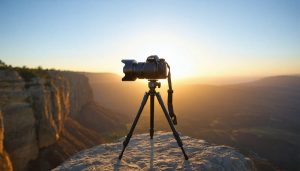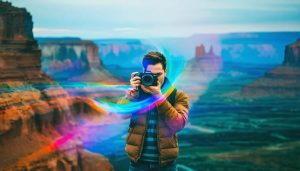
Grip the camera firmly with your right hand around the grip, and use your left hand to support the lens from underneath. Keep your elbows close to your body to maximize stability and reduce camera shake. When shooting in low light or with slower shutter speeds, brace yourself against a solid surface or lean against a wall to maintain steadiness. Experiment with your stance: stand with your feet shoulder-width apart or kneel down, which can significantly enhance your overall balance and control over the camera. Adjust your posture and positioning to suit different shooting scenarios, as this can often mean the difference between a blurry photo and a professional-looking one. For more tips and techniques to capture stunning images, explore our in-depth guides and learn how adjusting your camera handling can transform the quality of your photographs. These foundational steps are essential for both beginners and seasoned photographers aiming to elevate their craft.
The Basics of Camera Holding

Understanding Your Camera’s Weight and Balance
When holding your camera, understanding its weight and balance can significantly impact your shooting experience. Different camera models—like DSLRs, mirrorless, or compact point-and-shoots—each come with unique weight and balance profiles, influencing how you hold them. For instance, DSLRs are typically heavier, requiring a sturdier grip. You might cradle the lens with one hand while the other supports the body for optimal balance. On the other hand, lightweight mirrorless cameras may allow easier mobility, but it’s crucial to maintain stability by using a similar technique, especially with longer lenses. Experienced photographers often share tips from real-world scenarios—like balancing a telephoto lens by mounting it on a tripod collar—to maintain effective control. Remember, your stance also plays a role; a wide, stable stance helps you counterbalance your camera’s weight, preventing shaky shots. Experimenting with different hand positions and supports can help you find the technique that best suits your camera’s design and your personal comfort.
Proper Grip Techniques
For both enthusiasts and professionals alike, achieving a steady grip on your camera is crucial for capturing sharp, impactful images. The first step to master your grip is understanding optimal hand placement. Hold the camera body firmly but gently with your right hand, ensuring your index finger rests on the shutter button. Use your left hand to support the lens from beneath, providing stability. This grip not only combats shake but also allows for smoother adjustments.
Imagine photographing a breathtaking sunset; the last thing you want is a blurry image. By pressing the camera into your face, using your forehead as a third point of contact, you enhance stability. For added proficiency, plant your elbows tightly to your sides. This tripod effect is especially beneficial in low light or without a tripod.
To practice, start with slow breathing exercises while holding your camera, exhaling gently as you press the shutter. This can significantly reduce camera shake. Experiment with these techniques during casual photo sessions to gain confidence and precision, leading to consistently clearer shots.
Advanced Techniques for Stability
Using Your Body for Support
Imagine you’re out on a shoot, aiming for that perfect shot, but struggling to keep your camera steady. The solution might be simpler than you think: using your body for support. Begin by planting your feet about shoulder-width apart to create a stable base. Keep your left foot slightly forward and bend your knees a touch to lower your center of gravity. This posture mimics a slight athletic stance, giving you balance and control.
Next, tuck your elbows close to your sides. Think of them as the hinges of a stable tripod. With three anchor points—your two elbows and your face—holding the camera becomes easier and more consistent. As you bring the camera to your eye, gently press your elbows against your body to form a triangle with your arms, enhancing stability.
You can also lean against a wall, tree, or similar support for additional steadiness when possible. Remember, a steady body leads to sharper images and a more enjoyable shooting experience.

Leverage Environmental Supports
When you’re out in the field, leveraging environmental supports can be a game-changer for achieving sharper images. A tripod is a staple piece of equipment for many photographers, offering unmatched stability and versatility. Whether you’re shooting landscapes during a breezy day or capturing long exposures under the night sky, a sturdy tripod will keep your camera steady. Make sure to choose one that suits your camera’s weight to avoid unnecessary shake.
Monopods, on the other hand, provide a good balance of support and mobility. They don’t offer the same steadiness as tripods but can be perfect for sports photography or dynamic environments where you need to move quickly.
In cases where you don’t have a tripod or monopod, look around for natural supports like rocks, tree branches, or benches. These surfaces can be useful for stabilizing your camera. Try using your camera strap as an additional stabilizer by pulling it taut against a firm object. These techniques might just be the secret to sharper, clearer photos when traditional equipment isn’t available.
Breathing and Shutter Techniques
One crucial element of capturing sharp images is mastering your breathing and shutter technique. Before pressing the shutter, take a deep breath and exhale slowly. Timing your shot at the end of your exhale can minimize body movement, providing greater stability. Imagine how a marksman calms their breath before pulling the trigger; the same principle applies here for reducing camera shake. Additionally, gently squeezing the shutter button instead of jabbing it can prevent unwanted motion. Practice this technique regularly in various shooting scenarios, and you’ll soon notice a significant improvement in the clarity and sharpness of your photos.
Adapting to Different Shooting Scenarios
Low Light and Night Photography
Capturing images in low-light conditions or at night can be challenging, but with the right techniques, you can achieve stunning results. One crucial aspect of success in night photography is maintaining camera stability. Start by adopting a solid stance: stand with your feet shoulder-width apart and tuck your elbows close to your body to steady your hands. If possible, brace yourself against a sturdy object like a wall or tree. Using a tripod is often the best option, as it eliminates much of the natural shakiness that can occur during longer exposures.
If you don’t have a tripod, try the string trick: attach a string to your camera and step on it, pulling it taut to reduce movement. Additionally, make use of a remote shutter release or timer to avoid any shake from pressing the shutter button. With these tips, you can confidently capture breathtaking scenes, even in dim conditions. Remember, patience and practice are key to mastering low-light photography techniques.
Action and Sports Photography
Capturing the thrill of fast-moving subjects in action and sports photography requires quick reflexes and a stable grip on your camera. Begin by adopting a firm, balanced stance with your feet shoulder-width apart. This foundation minimizes unwanted movement. For added stability, tuck your elbows into your sides, creating a natural brace. Use both hands: your right should grip the camera body while your left supports the lens, allowing for nimble adjustments.
When tracking swift subjects, practice panning by following the movement smoothly with your camera. This helps reduce motion blur and creates dynamic shots. Use a higher shutter speed—1/1000th of a second or faster—to freeze action crisply. If the camera feels heavy after prolonged periods, rely on a monopod for both support and flexibility.
Above all, anticipate the action. Understand the predictable patterns in games or events to position yourself optimally and time your shots effectively. This foresight, combined with solid camera handling, will take your action photos to new heights.

Common Mistakes to Avoid
One common mistake many photographers make is neglecting proper hand positioning while holding the camera. It’s easy to default to holding the camera with one hand and operating the settings with the other, but this can lead to shaky images. Instead, use your non-dominant hand to support the base and lens of the camera, creating a stable platform for your dominant shooting hand to adjust settings and press the shutter. This simple adjustment can drastically reduce camera shake, allowing for sharper, clearer images.
Another frequent error is ignoring the role of posture and stance. Standing stiffly or awkwardly can hinder your ability to move smoothly and capture your desired shot. To combat this, think of your body as a tripod: spread your legs shoulder-width apart, keep one foot slightly ahead of the other, and bend your knees slightly. This stance provides a solid foundation and gives you the flexibility to adjust your positioning quickly as needed.
Photographers often forget the importance of breathing techniques, particularly when capturing images in low light or without a tripod. Holding your breath before clicking the shutter can seem instinctual, but this practice can actually introduce additional movement. Instead, exhale slowly as you press the shutter to minimize any movement of your hands.
Finally, make it a point to regularly review your camera settings. It’s easy to set your camera for one environment and forget to adjust it for the next, leading to poorly exposed images. Before shooting, glance at the ISO, aperture, and shutter speed to ensure they match your current conditions. These mindful habits, rooted in real-world practice, can elevate the quality and consistency of your photography.
Conclusion
Grasping the nuances of camera holding can transform your photography, making each shot sharper and more compelling. By consistently practicing the techniques covered in this guide, whether exploring landscapes or capturing candid moments, you’ll enhance your overall photography experience. Remember, even seasoned professionals revisit these fundamentals to maintain their skills. So, continue to refine your grip, stabilize your posture, and experiment with hand positions that suit your style. Embrace every chance to improve, as mastery of camera handling not only elevates your art but also deepens your connection to the scene you’re capturing. Keep shooting, and enjoy the journey towards photographic excellence.

















